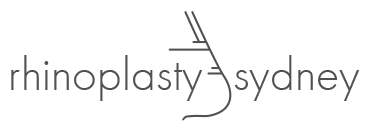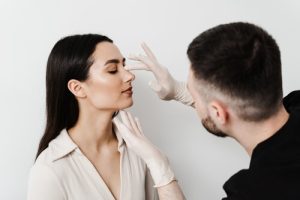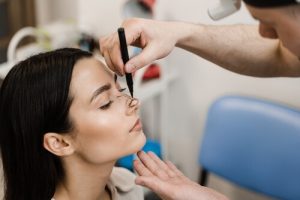Rhinoplasty, popularly known as a nose job, is a transformative procedure that can enhance the nose’s aesthetics and function. But like every surgical procedure, the journey doesn’t end when you leave the operating room; the path to your desired outcome is paved with patience, care, and time. And that’s where the rhinoplasty recovery timeline comes into play. How long does the swelling last?
When can you return to your daily routine? In this article, we will demystify the post-operative period, providing you with a detailed roadmap of the recovery process. Buckle up as we delve deep into what you can expect in the days, weeks, and months following your surgery.
Understanding the Rhinoplasty Procedure
The decision to undergo a rhinoplasty, commonly known as a nose job, should not be taken lightly. It’s a surgical journey that promises to refine, reshape, and enhance one’s facial aesthetics. But what exactly goes on during this intricate and complex procedure itself?
– A Glimpse into the Surgeon’s Playbook: At its core, rhinoplasty is a form of plastic surgery dedicated to the reshaping or resizing of the nose. The procedure can be both cosmetic, aiming to improve appearance, and functional, to address breathing problems or other issues. Depending on the individual’s needs and desires, a plastic surgeon can reduce the nose’s size, reshape the nose tip, narrow the nostrils, or change the angle between the nose and the upper lip.
– Open vs. Closed Rhinoplasty: Typically, two primary techniques are employed by surgeons: open and closed rhinoplasty. An open procedure involves an incision across the tissue that separates the nostrils, offering the surgeon a clear view and ample space to work. On the other hand, a closed rhinoplasty involves incisions made within the nostrils, leaving no external scars. The choice between the two often depends on the complexity of the surgery and the surgeon’s expertise.
– The Role of Anaesthesia: Safety is paramount. Hence, the procedure is typically performed under general anaesthesia or intravenous sedation. This ensures that the patient remains comfortable and pain-free throughout the operation.
– Recovery and Results: Post-surgery, most patients can expect some swelling and bruising, but these are temporary. Splints and internal tubes might be necessary for the initial week to support the newly reshaped nose structure. With time and proper post-operative care, the nose heals, revealing the anticipated changes that meld seamlessly with the patient’s facial features.
In conclusion, understanding the rhinoplasty procedure’s nuances equips potential candidates with the knowledge they need to make informed decisions. Entrusting this transformative journey to a skilled facial plastic surgeon ensures that the road to a newly refined nose is safe and satisfying.
How rhinoplasty surgery differs from other nasal surgeries
Rhinoplasty, while a prevalent form of nasal surgery, stands apart from other procedures targeting the nose. Here’s a closer look at the distinctions:
– Primary Objective:
The fundamental difference lies in the intent. Rhinoplasty primarily focuses on cosmetic alterations — reshaping, resizing, or enhancing the nose’s aesthetics. In contrast, other nasal surgeries often target functional concerns, such as correcting a deviated septum (septoplasty) or alleviating chronic sinus issues (endoscopic sinus surgery).
– Surgical Approach:
While rhinoplasty and other nasal procedures might employ open or closed surgical techniques, the specific maneuvers and modifications vary drastically. For instance, turbinate reduction, a third nose surgery used to improve airflow, involves reducing the size of the turbinates inside the nose, a step not common in typical rhinoplasties.
– Recovery Process:
Post-operative care and recovery timelines differ. While rhinoplasty might lead to notable facial swelling and the need for an external splint, other procedures, like sinus surgery, could result in internal discomfort and nasal congestion without significant external signs.
– Expected Outcomes:
The success metrics differ. Rhinoplasty’s success is often gauged by patient satisfaction with the new appearance and, in some cases, improved breathing. In contrast, the success of functional nasal surgeries is measured by alleviating symptoms, like better airflow or reduced sinus infections.
In summary, while rhinoplasty and other nasal surgeries address the nose’s structure, they diverge in purpose, technique, recovery, and desired outcomes. Being informed about these differences is essential for anyone considering nasal surgery to make the best decision for their needs.
Immediate Post Rhinoplasty: The First Few Weeks
The first six weeks after a rhinoplasty are vital for recovery. Patients commonly experience swelling and discomfort. Surgeons often apply protective splints to aid the healing of the reshaped nose. Following post-operative advice is essential:
- Keeping the head elevated
- Minimising facial movements
- Avoiding pressure on the nose, such as from glasses
While curiosity about the final result is natural, patience is key, as the nose’s true appearance emerges over time with proper care.
Tips to keep nasal passages clear and clean
Maintaining clear and clean nasal passages is crucial for optimal respiratory health and post-operative recovery. Here are some key strategies:
- Saline Rinse: Use a saline solution to flush out the nasal passages gently. This helps remove mucus and any particles, providing relief and reducing congestion.
- Stay Hydrated: Drinking plenty of water ensures mucus remains thin and less sticky, making it easier to expel.
- Humidify Your Surroundings: Using a humidifier adds moisture to the air, preventing dryness inside the nostrils and facilitating easier breathing.
- Avoid Irritants: Avoid smoke, dust, and strong odours, which can exacerbate congestion and inflammation.
- Regular Cleaning: Clean the external nostrils by wiping them with a soft, damp cloth to remove any buildup.
- Nasal Strips: These can help open the nasal passages, especially during sleep, ensuring better airflow.
- Limit Dairy Consumption: Some people find that dairy products can thicken mucus, so cutting back might help if congestion is a persistent problem.
By adhering to these guidelines, individuals can ensure their nasal passages remain free from obstructions, offering a comfortable breathing experience.
The importance of keeping the head elevated
Elevating the head, especially during recovery from certain procedures or injuries, holds significant value for various reasons:
- Reduces Swelling: Keeping the head raised minimises fluid buildup, reducing facial or cranial swelling, especially after surgeries like rhinoplasty.
- Promotes Healing: Elevation can enhance blood circulation to the affected area, promoting faster healing and reducing the risk of complications.
- Prevents Pain and Discomfort: Elevated positioning can alleviate pain by reducing pressure on the operated or injured area.
- Optimises Respiratory Function: An elevated head position can optimise airway patency, ensuring easier breathing, especially in individuals with nasal congestion or respiratory conditions.
- Minimises Acid Reflux: For those susceptible to acid reflux, keeping the head elevated while sleeping can prevent stomach acid from reaching the oesophagus, thus avoiding discomfort.
Keeping your head elevated is crucial in enhancing recovery, comfort, and overall health in various situations.
Why you shouldn’t blow your nose right after the nose reshaping surgery
Blowing your nose immediately after undergoing a nose reshaping procedure can be detrimental for the following reasons:
1. Risk of Bleeding: The nasal tissues remain fragile post-surgery. Forceful blowing might rupture delicate blood vessels and nasal bones, leading to unexpected bleeding.
2. Increased Swelling: Force exerted when blowing the nose can increase swelling and exacerbate inflammation, prolonging healing.
3. Displacement of Structures: Freshly adjusted cartilage or bone might get displaced due to the pressure, compromising the surgical outcomes.
4. Accumulation of Mucus: Instead of clearing the nasal passages, blowing might push mucus deeper, potentially causing blockages.
5. Risk of Infection: Introducing external contaminants or bacteria by frequently touching the nose can increase the risk of post-surgical infections.
Given these concerns, patients are typically advised to refrain from blowing their nose for a specified duration after a nose reshaping surgery to ensure optimal recovery and desired results.
Rhinoplasty Recovery Tips: Navigating the Healing Process
Embarking on a rhinoplasty journey requires not only understanding the surgery but also knowing how to navigate the post-operative phase effectively. Recovery is a pivotal aspect with its own set of challenges. Here are essential tips for a smooth healing process:
- Prioritise Rest: Give your body ample time to heal, especially in the initial days.
- Stay Elevated: Keep your head raised, even during sleep, to minimise swelling.
- Avoid Nose-Blowing: Refrain from blowing your nose to prevent complications, as the internal structures are still settling.
- Stay Hydrated and Nourished: Consuming a balanced diet and drinking plenty of water accelerates tissue repair.
- Limit Physical Activities: Engage in low-impact activities and avoid strenuous exercises to protect the surgical site.
- Follow Post-op Instructions: Adhering to the surgeon’s guidance, from wound care to medications, ensures optimal results.
Being proactive and patient during the healing process lays the foundation for successful outcomes and a transformed aesthetic.
How to reduce swelling during the recovery period
Swelling is an anticipated outcome after rhinoplasty, but effective ways exist to mitigate its severity and duration. Here’s how to manage and reduce swelling after rhinoplasty and post-surgery:
– Cold Compress: Gently applying a cold compress around the surgical site, without direct contact, can alleviate swelling, especially in the first 48 hours.
– Head Elevation: Sleep with your head elevated higher than your heart. This promotes drainage and diminishes fluid accumulation.
– Avoid Salty Foods: Excessive salt can exacerbate swelling. Opt for a low-sodium diet during the initial recovery phase.
– Stay Hydrated: Drinking ample water flushes out toxins and aids in reducing inflammation.
– Limit Physical Activity: Refrain from strenuous exercises and activities that can increase blood pressure and flow to the face, worsening the swelling.
– Follow Medication Guidelines: Use prescribed anti-inflammatory medications as your surgeon directs.
Proactively addressing swelling ensures a more comfortable recovery and a clearer view of your surgery’s results.
When and how to wear glasses post-surgery
Wearing glasses following rhinoplasty requires careful consideration to avoid jeopardising the surgery results. Here’s what you need to know:
- Immediate Post-Surgery: It’s advisable to refrain from wearing glasses directly on the nose for the first 4-6 weeks after surgery.
- Alternative Support: Consider using cheek rests or specialised tape to offload the weight of the glasses from the nasal bridge.
- Lightweight Frames: If wearing glasses is essential, opt for lighter frames or contact lenses, reducing stress on the healing site.
- Consultation: Always consult your plastic surgeon about when it’s safe to resume wearing glasses without restrictions.
- Avoid Pressure: Ensure your glasses fit correctly and don’t exert excessive pressure on the nose, especially the bridge.
Being cautious about how and when you wear your glasses can safeguard the integrity of your rhinoplasty results.
Signs that your rhinoplasty recovery time is on track
Monitoring the progress of your rhinoplasty recovery is crucial to ensure optimal healing and desired results. Key indicators of a smooth recovery include:
- Reduced Swelling: Over the first few weeks, a noticeable reduction in swelling, especially around the nasal bridge and tip, indicates healing.
- Diminished Pain: While mild discomfort is normal initially, its gradual subsidence suggests the recovery is on track.
- Steady Breathing: Clear nasal passages and the absence of breathing difficulties signal that internal healing is progressing well.
- Absence of Prolonged Redness or Discoloration: The fading of initial post-surgical redness or bruising is a good sign.
- Intact Sutures: Sutures remaining in place, without signs of undue stress or tearing, indicate a healing process without complications.
- Feedback from Follow-up Appointments: Positive evaluations from your plastic surgeon during scheduled check-ups underscore a favourable recovery trajectory.
Recognising these signs can offer peace of mind and confidence in the procedure’s success and aftermath.
When to be concerned during your rhinoplasty recovery time
As you navigate the healing process post rhinoplasty, you must know potential red flags that may indicate complications. Here are signs that should prompt immediate consultation with your plastic surgeon:
– Excessive Swelling or Bruising: While some swelling and bruising are expected, prolonged or extreme manifestations could suggest an underlying issue.
– Severe Pain: Persistent or escalating pain that doesn’t respond to prescribed pain relief might signal a problem.
– Fever or Signs of Infection: Any persistent fever or increasing redness, warmth, or discharge from the surgical site may indicate an infection.
– Breathing Difficulties: An obstructed airway or consistent trouble breathing post-surgery is a cause for concern.
– Unusual Nasal Discharge: Any yellow-green discharge or continuous bleeding from the nostrils is not typical and should be addressed.
– Asymmetry or Unsettling Appearance: If, after initial bruising and swelling subsides, there’s noticeable asymmetry or an appearance that causes concern, it’s worth discussing with your surgeon.
Timely identification and action on these concerns can ensure that your recovery stays on track and that any potential issues are promptly addressed.
Conclusion
Understanding the rhinoplasty recovery timeline is crucial for anyone considering or having undergone a nose job. Just as the procedure requires a skilled surgeon, the post-operative phase demands patience, adherence to guidelines, and awareness of one’s healing progression.
Eager to understand your rhinoplasty recovery timeline? At Refine Clinic, we prioritize your post-surgical journey as much as the procedure itself. Our dedicated team, comprising top-tier rhinoplasty surgeons, ensures that your healing process is smooth, helping you step confidently into your rejuvenated look.
Embark on a transformative journey with our state-of-the-art rhinoplasty procedures and comprehensive recovery guidance. For a detailed recovery timeline tailored to you, reach out to us today. We’re here to illuminate every step of your path to beauty excellence.
References
What to expect during your rhinoplasty recovery
https://www.plasticsurgery.org/news/blog/what-to-expect-during-your-rhinoplasty-recovery
WHAT TO EXPECT WHILE RECOVERING FROM A RHINOPLASTY
https://healthcare.utah.edu/the-scope/health-library/all/2019/09/what-expect-while-recovering-rhinoplasty
Rhinoplasty (Nose Job)
https://my.clevelandclinic.org/health/treatments/11011-rhinoplasty
Nose reshaping (rhinoplasty)
https://www.nhs.uk/conditions/cosmetic-procedures/cosmetic-surgery/nose-reshaping-rhinoplasty/
Rhinoplasty (Nose Surgery)
https://www.dukehealth.org/treatments/cosmetic-surgery/rhinoplasty




Recent Comments